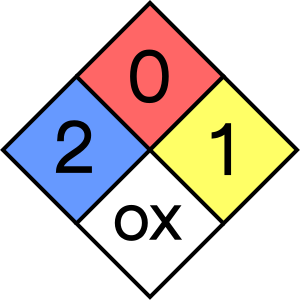SODIUM HYPOCHLORITE
Basic information
NFPA 704 (fire diamond)

- Health (blue): 2 - intense or continued but not chronic exposure could cause temporary incapacitation or possible residual injury.
- Flammability (red): 0 - will not burn under typical fire conditions, will not burn in air unless exposed to a temperature of 820 °C for more than 5 minutes.
- Instability–reactivity (yellow): 1 - normally stable, but can become unstable at elevated temperatures and pressures.
- Special notice (white):
- OX - oxidizer - allows chemicals to burn without air supply.
Hazard statements
| Code | Phrase |
|---|---|
| H302 | harmful if swallowed |
| H314 | causes severe skin burns and eye damage |
| H410 | very toxic to aquatic life with long lasting effects |
Precautionary statements
| Code | Phrase |
|---|---|
| P260 | do not breathe dust/fume/gas/mist/vapours/spray |
| P264 | wash … thoroughly after handling |
| P273 | avoid release to the environment |
| P280 | wear protective gloves/protective clothing/eye protection/face protection |
| P301+P330+P331 | IF SWALLOWED: rinse mouth, do NOT induce vomiting |
| P303+P361+P353 | IF ON SKIN (or hair): remove/take off immediately all contaminated clothing, rinse skin with water or shower |
| P304+P340 | IF INHALED: remove victim to fresh air and keep at rest in a position comfortable for breathing |
| P305+P351+P338 | IF IN EYES: rinse continuously with water for several minutes, remove contact lenses if present and easy to do, continue rinsing |
| P310 | immediately call the ETH Emergency Desk: +41 44 342 11 88 (from mobile) or 888 (from landline) |
| P321 | specific treatment (see the label) |
| P363 | wash contaminated clothing before reuse |
| P391 | collect spillage |
| P405 | store locked up |
| P501 | dispose of contents/container to HCI-Shop |
Protective measures
Gloves
Occupational Safety and Health Act of 1970 and OSHA Glove Selection Chart do not provide recommendation on gloves for handling sodium hypochlorite. California State University categorizes gloves into four protection levels (excellent, good, fair, poor (not recommended)) for given chemical. The levels of protection against sodium hypochlorite for four types of gloves are:
- Neoprene: N/A
- Natural latex or rubber: excellent.
- Buthyl: N/A
- Nitrile: excellent.
Safety goggles
- Always wear safety goggles when handling sodium hypochlorite. Corrective glasses are not considered safety googles.
- Handle sodium hypochlorite inside the fume hood only (with exception of moving the closed bottle to and from the storage cabinet).
Clothing
- Wear long trousers and fully covered shoes.
- Contact lenses are forbidden while working with chemical substances, even in combination with safety glasses.
- Do not wear cosmetics.
- Do not wear synthetic clothing while working with flammable liquids or gases or when a hazard is present as these materials tend to melt and stick to exposed skin.
- Do not wear headphones.
Spill management
- Use personal protective equipment.
- Avoid dust formation, avoid breathing dust.
- Avoid breathing vapors or mist.
- Ensure adequate ventilation.
- Evacuate personnel to safe areas.
- Sweep up without creating dust and arrange disposal.
- Do not let it enter drain.
- If a spill happened outside the fume hood (on the floor or desktop) contact Dr Jakub Tkaczuk (+41 44 632 31 62) and the ETH Emergency Desk (+41 44 342 11 88 from mobile or 888 from landline).